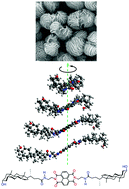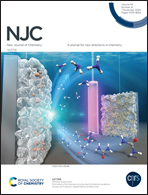Selectivity and bio-compatibility of self-assembled chiral flower-like and helical nanostructures†
Abstract
The molecular building block NDI–LCA was synthesized via substitution of NDA at the di-imide position with two lithocholic acid moieties. It was found that the NDI–LCA conjugate exhibits good thermal stability. The photophysical data including UV-vis and fluorescence spectral measurements and theoretical calculations reveal that NDI–LCA possesses stronger absorption and fluorescence emission properties. Furthermore, the NDI–LCA derivative self-assembled into chiral flower-like structures in the THF/MCH solvent mixture, whereas NDI–LCA in THF/water produces chiral fibril nanostructures. The formation of supramolecular self-assembly in solution was characterized using UV-vis spectroscopy, fluorescence spectroscopy, and dynamic light scattering (DLS). Circular dichroism is used to study chiral induction in supramolecular structures. The structure formed on the silicon wafer was confirmed using Scanning Electron Microscopy (SEM). X-Ray diffraction (XRD) clearly showed the crystalline morphology. In addition,the supramolecular structures of NDI–LCA in THF exhibit remarkable bio-compatibility and increased cellular uptake in cancer cells. From cell morphology and uptake studies, it can be assumed that NDI–LCA in THF supramolecular structures can act effectively as a platform for both cell markers and as a delivery agent for further studies.



 Please wait while we load your content...
Please wait while we load your content...